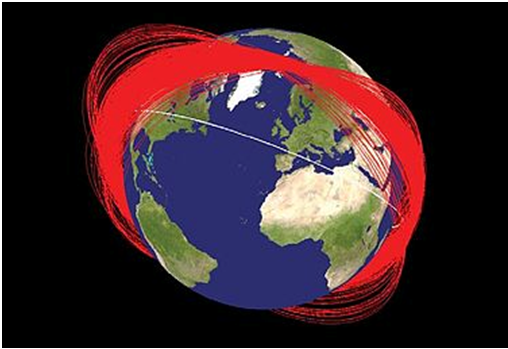China has been working on anti-satellite weapons systems (ASAT) since 1964. They have been developing three types of ASAT systems including Directed Energy, Micro-satellites and Direct Fire. There was an interruption of progress during the Cultural Revolution in the 1960s.
Directed Energy weapons consist of laser or microwave beams from the ground that damage the electronics of a satellite. While Directed Energy ASAT systems are not able to destroy a satellite, they can render one useless. The development of this type of ASAT system has been dependent on the creation of extremely powerful lasers and microwave projectors. The Chinese have been working on a high powered ASAT laser system since 1995. This system was tested on a U.S. satellite in 2006. The U.S. satellite detected bright laser light flashes from Earth but the flashes were not aimed at the lenses of the satellite and caused no damage.
Micro-satellites are defined as orbital objects that are between twenty pounds and one thousand pounds. This includes both man-made satellites launched into orbit as well as orbital debris. Micro-satellites are inexpensive to build and launch. Any micro-satellite with maneuvering capability could become an ASAT system simply by arranging for it to collide with another satellite. The Chinese have claimed that they have developed a satellite that can attach itself to other satellites. It could then be detonated at any time. There has been no demonstration of such a satellite so it may not actually exist.
A Direct Fire System involves the launch of a missile from the ground or from a submarine that rises into orbit and collides with a satellite. The Chinese tested such weapons in 2005 and 2006, but the tests failed. In 2007 China launched a DF-21 multistage solid-fuel medium range ballistic missile from Xichang Space Center with a Kinetic Kill Vehicle mounted as the payload. The missile traveled over five hundred miles into space and slammed head on into the Chinese Feng Yun 1C satellite at about four miles per second. The Feng Yun 1C was a old Chinese weather satellite weighing one thousand six hundred and fifty pounds. It was travelling in a polar orbit at five hundred and thirty seven miles.
The destruction of the Feng Yun 1C created a large field of orbital debris with over two thousand trackable pieces larger than a golf ball. In addition, there are an estimated one hundred and fifty thousand small particles in the debris field. The debris from the Feng Yun 1C passed near the International Space Station and recently destroyed a Russian nanosatellite.
The United States halted their tests of Direct Fire ASAT systems in 1985 partly because of concern over the debris that such tests create. The debris that already orbits the Earth poses a major threat to existing and future satellites. The orbital debris includes nuts, bolts, tools, frozen fuel droplets, flecks of paint and other particles from disintegrating satellites. These objects can be traveling as fast as seventeen thousand miles per hour and they can seriously damage satellites and spacecraft.
Orbital plane of Feng Yun-1C debris a month after its destruction:
